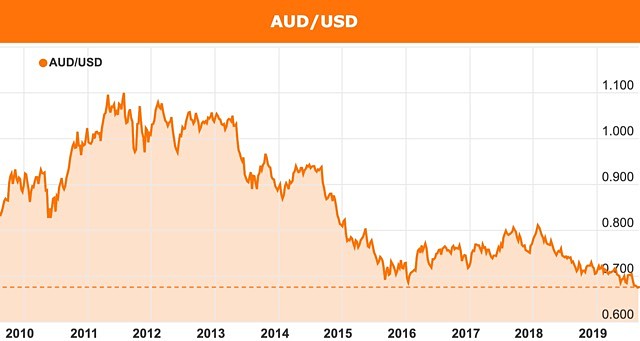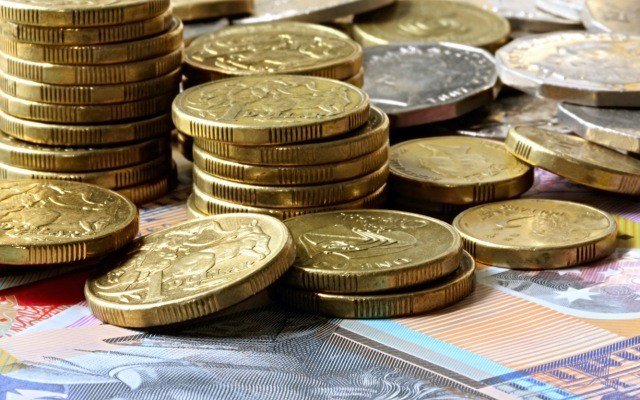After the US-China trade war ramped over the weekend, the Australian dollar has sunk to its lowest point in a decade, falling to about US67.24c in trading on Monday.
The last time the Aussie dollar descended to this level was in March 2009, when it bottomed out at around US67.44c.

While the currency has been on a gradual decline for more than 1.5 years, it fell dramatically from around US70c in mid-July to US68c at the start of August and has struggled to recover over the course of the month.
Trade war kicks Chinese yuan while it’s down
Currency experts believe the Australian dollar is likely to remain under pressure from the continued fall in the Chinese yuan, which sunk to an 11-year low of 7.147 per US dollar on Monday.
“When there’s a sharp move in the yuan, the Aussie [dollar] does tend to react in the same direction,” Westpac senior currency strategist Sean Callow told media.
“Any time you see that it has a ripple effect around the region, other currencies weaken in sympathy and the Aussie [dollar] goes with it,” he said.
The yuan’s decline follows the latest escalation in an unrelenting trade dispute between the two economic superpowers of China and the United States.
Last week, China announced it would impose new tariffs on US$75 billion of US products.
US President Donald Trump retaliated by declaring the US would raise its existing tariffs on US$250 billion of Chinese imports from the current 25% to 30% from 1 October.
President Trump also said planned tariffs on a remaining US$300 billion of Chinese goods would be raised from 10% to 15%.
These tit-for-tat actions escalated to a point where President Trump “hereby ordered” US companies to seek alternatives to doing business in China.
However, Beijing’s top negotiator reportedly said China was “willing to resolve the issue through consultations and cooperation in a calm attitude”.
Later on Monday, President Trump said on the sidelines of the Group of 7 (G7) meeting in France that the US would return to the negotiations.
Trump meets ScoMo at G7
While attending the G7 summit, President Trump also discussed trade with Australian Prime Minister Scott Morrison, who expressed concerns about the impact the US-China trade war is having on the global economy.
During a doorstop interview on the sidelines of the talks, Mr Morrison said he wanted to see the US-China dispute resolved “sooner rather than later”.
“It does have, obviously, a broader impact on the global economy, but equally, you can’t just brush these issues aside forever – they have to be dealt with and we obviously want to see that happen as well,” he said.
Australia attended as an observer state with the summit formally confined to the US, Canada, UK, France, Italy, Germany and Japan.
French President Emmanuel Macron also invited other nations including India, Chile and South Africa, plus Iran’s foreign minister made a surprise visit.
Australian share market tumbles
Along with the falling Aussie dollar, the Australian share market took a hit, losing about $30 billion on opening on Monday.
By afternoon trade, the benchmark ASX 200 index had lost 100 points or 1.55%, slipping to 6,422 – a disappointing turn after it gained 1.8% last week.
However, it recovered some of its early trading losses by close of trade, ending down 83 points or 1.3% at 6,440.
The weakest performance came from the energy, technology and healthcare sectors, while gold stocks stayed safe thanks to the metal’s climbing price.
Petrol prices soar
Meanwhile, the weakened Australian dollar has pushed petrol prices to a four-year high, according to the consumer watchdog.
In its June quarter report on the petrol market, the Australian Competition and Consumer Commission (ACCC) posted an average annual price for the 2019 financial year in Australia’s five largest cities of 141.2c per litre – 7c/L higher than the previous year.
ACCC chair Rod Sims sited the depreciated AUD-USD exchange rate as the most significant contributor to the price hike.
“The AUD-USD exchange rate is a significant determinant of Australia’s retail petrol prices because international refined petrol is bought and sold in US dollars in global markets,” he said.
Analysts forecast continuing decline
The Australian dollar is sliding closer to Capital Economics’ prediction at the start of the year of US$0.60, with the research firm envisaging it will remain at that level until 2020.
While the falling Aussie dollar is not favourable for everyone, it’s good news for Australian exporters as well as investors with offshore earnings.
Gold miners will also be rejoicing in the lower dollar as it has resulted in gold in Australian-dollar terms reaching all-time record highs, with the price pushing past A$2,300 per ounce on Monday.
